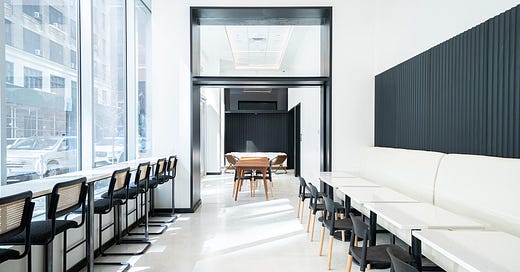DoorDash Kitchens has a new location, but it's still a one-off
If this was going to scale, it would have happened already.
On Monday, DoorDash announced a new location of DoorDash Kitchens in downtown Brooklyn. It features both local favorites — Pies ‘n’ Thighs, Domodomo — and nationally recognized brands — Milk Bar and… Little Caesars among them. The restaurants provide the staff that makes the food. DoorDash handles restaurant partnerships, ordering, and delivery; its partner, local ghost kitchen company Nimbus — once described in Grubstreet as “a ghost kitchen with… a human touch” — manages the facility. Like the Manhattan location of Nimbus, the new Brooklyn DoorDash Kitchens has some seating for dine-in customers, too.
It’s the fourth such opening for DoorDash, which also runs DoorDash Kitchens locations in Hollywood and Redwood City, south of San Francisco. A pop-up location in San Jose closed, but should reopen in a nearby location later this year. (The pop-up was a full service kitchen, meaning restaurants didn’t have to provide employees to cook in the space. DoorDash still offers that service to some of its Redwood City restaurant partners.)
So is it a ghost kitchen if it’s accessible to diners? (Other outlets have referred to it as a “food hall” or “food-hall-style ghost kitchen.”) I tackled this a year ago, but the point is the same: A more visible ghost kitchen isn’t simply a restaurant, even if walking into one feels more akin to a fast-casual experience than the next wave of successful restaurant businesses. That’s because part of what makes a ghost concept or virtual brand is its technology. So, it makes sense that the non-technical parts of the business — the kitchens and the real estate — are moving out of the shadows.
In this particular case, the dine-in piece seems to be an integral part of Nimbus’s business, not DoorDash’s. ““We’re proud to partner with DoorDash by providing turn-key kitchen infrastructure and community event spaces to their restaurant partners,” Nimbus co-founder and CEO Camilla Opperman said in a statement. At Nimbus’s original Manhattan location, the guest-facing space was intended to be a way for guests to interact with the restaurants, taking the whole “ghost” thing out of ghost kitchens. (As discussed last week, these sorts of hybrid brick-and-mortar spaces are an important part of the “post-ghost” restaurant era.)
Semantics aside, these one-off operations feel more like a marketing opportunity and less like a growth strategy. They likely don’t suggest some huge repositioning for DoorDash; opening four brick-and-mortar locations over a few years hardly moves the needle on a strategy shift. But it is good consumer and restaurant marketing. I covered DoorDash’s San Jose pop-up last summer for the San Francisco Chronicle, suggesting that the delivery company’s foray into staffing restaurants suggested it was looking to diversify, underwriting some restaurants’ operating costs for a portion of the profits in return. But the model hasn’t exactly taken off, even as plenty of restaurants continue to offer robust delivery options.
The whole point of DoorDash’s spaces is to extend the reach of restaurants on DoorDash, a good idea in markets hungry for certain concepts. And when I’ve talked to DoorDash Kitchen partner operators in the past, they’ve said they were thrilled to be a part of the project. But this feels like an extremely specific use case in exceptional, or at least big, markets — ones that benefit from multiple locations of beloved local favorites. DoorDash’s big responsibility in Brooklyn is one of its core competencies: providing food ordering and delivery for restaurant businesses. That’s all that’s really happening here, with the added benefit of heightened consumer awareness and some pretty chairs and tables, too.





